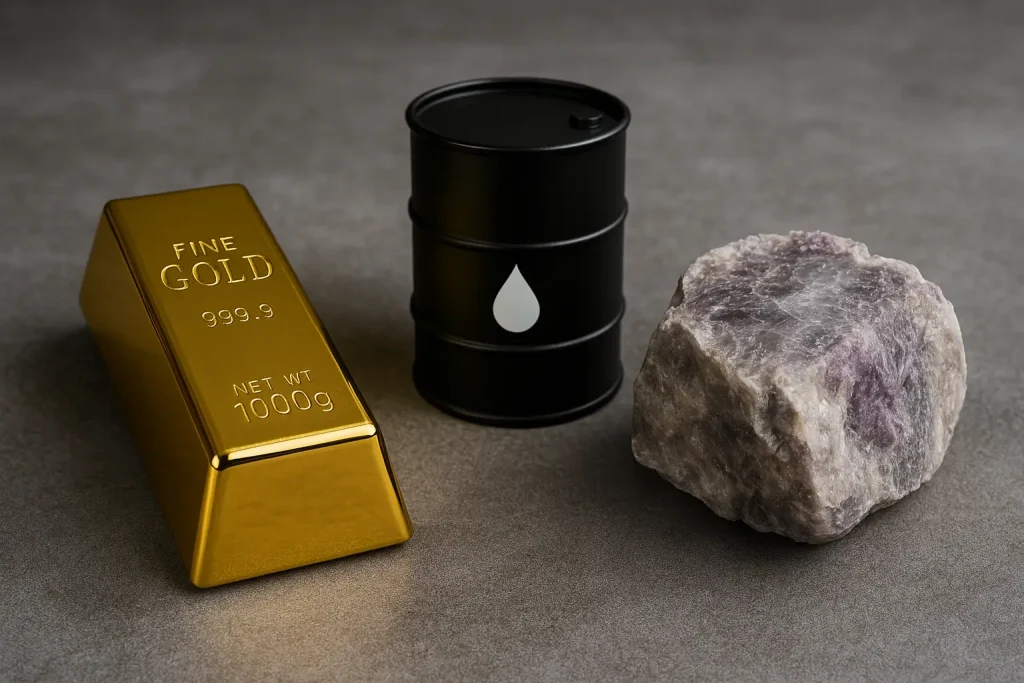With inflation volatility and shifting global markets, commodities in focus have re-emerged as a cornerstone of investment strategy in the United States. As traditional assets face pressure from interest rate adjustments and political uncertainty, investors are turning to tangible resources like gold, oil, and lithium for portfolio stability. These commodities offer both defensive protection and growth potential in turbulent times.
Each commodity reflects a distinct role in the U.S. economy. Gold serves as a safe-haven asset, oil drives industrial productivity, and lithium powers the clean energy revolution. Together, they highlight how commodities in focus can shield investors from macroeconomic shocks while positioning them for long-term structural transformation in energy and technology sectors.
Page Contents
ToggleGold, Oil, and Lithium: A Strategic Trio

Gold remains the quintessential hedge against inflation and currency depreciation. Its historical resilience makes it a vital component of diversified portfolios. Meanwhile, oil — despite growing renewable competition — remains indispensable for global trade, transport, and manufacturing. Its price dynamics mirror geopolitical risks and energy demand, reinforcing its relevance among commodities in focus.
Lithium, the metal behind modern battery technology, has become the new frontier for investors seeking exposure to the clean energy boom. As electric vehicles and grid storage expand, lithium’s strategic importance rivals that of oil in the 20th century. The growing demand underlines why commodities in focus are no longer just defensive tools but key pillars of innovation and sustainability.
Pros and Cons of Investing in Commodities
While the appeal of commodities in focus continues to grow, investors should weigh the potential rewards against the inherent risks before allocating capital. These markets are often cyclical and influenced by external shocks that can amplify volatility. Understanding both sides of the equation is crucial to building resilient investment strategies.
| Pros | Cons |
|---|---|
| Strong hedge against inflation and currency risk | High volatility linked to global supply and demand |
| Tangible assets with intrinsic value | Exposure to geopolitical and regulatory disruptions |
| Portfolio diversification benefits | Difficult to predict long-term price trends |
| Increasing role in green and digital transitions | Storage and liquidity challenges for physical assets |
Market and Policy Outlook
The U.S. government’s push for energy independence and sustainability is reshaping commodity markets. Subsidies for electric vehicles and renewable infrastructure are accelerating lithium demand, while strategic petroleum reserves continue to influence global oil pricing. These policy shifts highlight the growing intersection between energy, technology, and finance, reinforcing the importance of commodities in focus in shaping future investment landscapes.
However, rising global tensions and fluctuating interest rates could distort commodity valuations. Investors must remain agile, monitoring fiscal policy, production cuts, and trade dynamics that affect supply chains. As diversification gains priority, commodities in focus are likely to remain essential components of both institutional and individual portfolios.
The Role of Technology in Commodity Markets
Artificial intelligence and blockchain are revolutionizing how investors trade and track commodities in focus. These tools enhance transparency, improve logistics, and enable predictive analytics that anticipate price movements. As financial technology matures, the commodity sector becomes more accessible and efficient for global participants.
Conclusion
In conclusion, commodities in focus—gold, oil, and lithium—represent more than traditional safe-haven assets. They are strategic instruments that bridge economic security and technological advancement. For U.S. investors, they provide both a buffer against instability and a pathway toward future growth.
Nevertheless, success depends on diversification and informed timing. By aligning with policy trends and global sustainability goals, investors can ensure that commodities in focus remain a cornerstone of resilient and forward-thinking portfolios in an unpredictable economic era.




